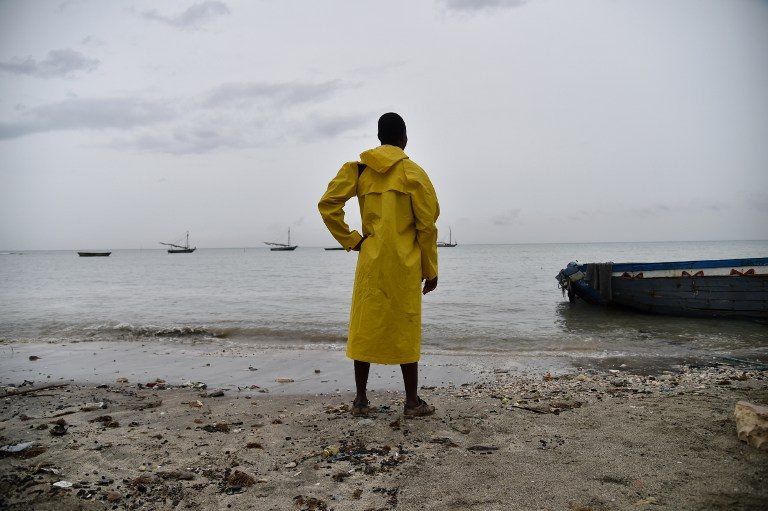SUMMARY
This is AI generated summarization, which may have errors. For context, always refer to the full article.

PORT-AU-PRINCE, Haiti (3rd UPDATE) – Hurricane Matthew made landfall in southwestern Haiti early Tuesday, October 4, triggering major floods and forcing thousands to flee the path of the deadly storm that has already claimed 3 lives in the poorest country in the Americas.
The National Hurricane Center said Matthew made landfall shortly after daybreak as an “extremely dangerous” Category Four storm near the town of Les Anglais, packing maximum sustained winds of around 145 miles (230 kilometers) per hour.
The most menacing storm in nearly a decade, Matthew began battering Haiti late Monday with strong winds and rising sea levels, before slamming ashore some 250 miles west of the capital Port-au-Prince.
Even before making landfall along the southern edge of a jagged peninsula on Hispaniola – the divided island that Haiti shares with the Dominican Republic – Matthew was blamed for at least 3 deaths in Haiti, with fears that the toll could climb.
By 1500 GMT it had traveled to the Gulf of Gonave on Haiti’s west coast, en route to Cuba, the Bahamas and other parts of the Caribbean.
Matthew notched a 4 on the 5-level Saffir-Simpson wind scale, the first Category Four hurricane to make landfall in Haiti since Cleo in 1964, the NHC said.
The hurricane was forecast to dump 38 to 63 centimeters (15 to 25 inches) of rain over southern Haiti with up to a meter possible in isolated areas.
Rising waters already have caused extensive flooding in and around the flimsy homes and buildings in Haiti’s southwest.
More than 6,400 Haitians have been evacuated to temporary shelters, although civil protection forces have struggled with locals who refused to leave some of the most vulnerable areas.
They included the capital’s extremely impoverished, densely populated neighborhoods, including Cite Soleil – where one fifth of the half-million residents face serious flooding risks – and the seaside Cite L’Eternel.
First deluge, then mudslides
Part of the seaport city of Les Cayes was underwater after being deluged by Matthew, which now is blamed for triggering mudslides.
“We have already recorded a landslide between Les Cayes and Tiburon” in Haiti’s Sud department, Marie-Alta Jean-Baptiste, director of Haiti’s civil protection told AFP.
Haiti is home to almost 11 million people, many living in fragile housing.
Thousands are still living in tents in Haiti after the country’s massive earthquake in 2010. Erosion is especially dangerous because of high mountains and a lack of trees and bushes in areas where they have been cut for fuel.
The head of one international relief group warned not just about the physical ravages from Matthew, but health risks as well.
“As it struggles with Zika and a prolonged cholera epidemic, this hurricane is a natural disaster that compounds an already desperate public health situation,” said Gary Gottlieb, the CEO of the group Partners in Health.
UNICEF said it worries in particular about the plight of Haiti’s vulnerable children.
“Water-borne diseases are the first threat to children in similar situations – our first priority is to make sure children have enough safe water,” the group said.
Blankets, plastic sheeting
Interim President Jocelerme Privert urged Haitians to do what they could to get out of the path of the storm.
“My countrymen, do not be stubborn, do not say ‘God is good’ and will take care of you,” he said in an address on Monday.
“We have no interest in risking your lives.”
In nearby Jamaica, officials said the army and military reserves were called up to help deal with hurricane damage. Buses were also sent to flood-prone areas to move residents to shelters.
USAID said it has dispatched an elite disaster response team to Haiti, Jamaica and the Bahamas.
It also is sending some $400,000 in assistance to aid groups in Haiti and Jamaica for “critical relief to those impacted by the storm,” and emergency relief supplies, including blankets, plastic sheeting and collapsible water containers.
The Red Cross has also deployed disaster teams to the countries most severely affected by Matthew.
Cuba has evacuated some 316,000 people from the east of the island, where Matthew was expected to hit later Tuesday.
“No one likes to leave their homes, but the sea is going to rise and that is very dangerous,” said Pedro Gonzalez, a retired chef who had to leave a fishing islet where he lives off the city of Santiago.
Forecasters predict the hurricane could hit the US East Coast around midweek. Florida and parts of North Carolina have declared states of emergency. – Rappler.com
Add a comment
How does this make you feel?
There are no comments yet. Add your comment to start the conversation.